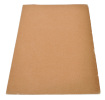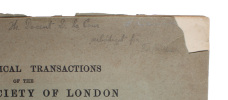2 books for « bohr n iels »Edit
On the Theory of the Decrease of Velocity of Moving Electrified Particles on passing through Matter. [Off-print From the Philosophical Magazine (Vol. 25, No. 145) for January 1913 ]. - [THE FOUNDATION OF BOHR'S ATOMIC THEORY - PRESENTATION-COPY]
[London, Taylor & Francis], 1913. 8vo. Original printed wrappers. The fragile wrappers are detached, but fully intact. Merely tiny parts of the thin backstrip lacking. Three small tears to front wrapper, no loss, as well as a couple of creses. Back wrapper with a slight bend to the corner and minor fading to extremities. Pp. (9)-31.
Scarce first edition, off-print issue with presentation-inscription, of Bohr's seminal first work on nuclear physics, being the work that lays the foundation for his atomic theory (published before his ""On the Constitution of Atoms and Molecules""), in which he is able to conclude ""that a hydrogen atom contains only 1 electron outside the positively charged nucleus, and that a helium atom only contains 2 electrons outside the nucleus ."" ""Bohr's 1913 paper on alpha-particles [i.e. the present], which he had begun in Manchester, and which had led him to the question of atomic structure, marks the transition to his great work, also of 1913, on that same problem. While still in Manchester, he had already begun an early sketch of those entirely new ideas."" (Pais, p. 128). The present work must be considered one of the most important to the birth of modern atomic theory.The work is inscribed to renowned Danish physicist and meteorologist Dan la Cour (1876-1942), son of the great Poul la Cour (1846-1908), who is considered the ""Danish Edison"". The inscription reads as thus: ""Hr. Docent Afdelingschef D. la Cour/ med venlig Hilsen/ fra/ Forfatteren."" [In Danish, i.e.: ""Mr. Assistant Professor Head of Department D. la Cour/ with kind regards/ from/ the author.""].Dan la Cour was the assistant of Niels Bohr's father, Christian Bohr, and a well known scientist. From 1903, he was head of the department of the Meteorological Institute, and from 1923 leader thereof. From 1908 he was Associate Professor at the Polytechnic College. His original scientific works are highly respected, as are his original apparati for measuring earth magnetism which are considered highly valuable. ""His original intelligence, which in many ways resemble that of his father, also bore fruit in his patenting of various inventions: the ""Pyknoprobe"", developed to quickly determine the different layers of the sea"" a use of termite in quickly heating food and drinks out in the open under unfavourable weather conditions."" (From the Danish Encyclopaedia - own translation). He wrote a number of important and esteemed works and was member of the Danish Scientific Academy as well as many prominent international scientific commissions of meteorology and geophysics (i.e. president of the International Geodetical and Geophysical Union). He was also honorary Doctor at the George Washington University. After finishing his studies in Copenhagen, Bohr went to Cambridge in order to pursue his studies on electron theory under the guidance of J.J. Thompson. Thompson, who was beginning to lose interest in the subject by now, did, however, not recognize the genious of the young Bohr, and as soon as he could, Bohr went to Manchester, where Ernest Rutherford had established a laboratory. ""There, from March to July 1912, working with utmost concentration, he [i.e. Bohr] laid the foundation for his greatest achievements in physics, the theory of the atomic constitution."" (DSB). Bohr's survey of the implications of Rutherford's atomic model had led him to attack the much harder problem which lay at the core of it, namely determining the exact nature of the relation between the atomic number and the number of electrons in the atom. ""Bohr obtained a much deeper insight into the problem by a brilliant piece of work, which he - working, as he said, ""day and night"" - completed with astonishing speed"" (DSB), that paper being the present ""On the Theory of the Decrease of Velocity of Moving electrified Particles on passing through Matter"", which thus constitutes his very first publication on the subject, published immediately after this dense period of 1912, in the Philosophical Magazine of January 1913. ""The problem was one of immediate interest for Rutherford's laboratory: in their passage through a material medium, alpha particles continually lose energy by ionizing the atoms they encounter, at a rate depending on their velocity. Their energy loss limits the depth to which the particles can penetrate into the medium, and the relation between this depth, or range, and the velocity offers a way of determining this velocity. What Bohr did was to analyze the ionizing process on the basis of the Rutherford model of the atom and thus express the rate of energy loss in terms of the velocity by a much more accurate formula than had so far been achieved-a formula, in fact, to which modern quantum mechanics adds only nonessential refinements"" (DSB). In the present work, Bohr was thus able to conclude: ""In this paper the theory of the decrease of velocity of moving electrified particles in passing through matter is given in a form, such that the rate of the decrease in the velocity depends on the frequency of vibration of the electrons in the atoms of the absorbing material."" as well as the seminal words that have been formative for the birth of the modern atomic theory: ""Adopting Prof. Rutherford's theory of the constitution of atoms, it seems that it can be concluded with great certainty, from the absorption of alpha-rays, that a hydrogen atom contains only 1 electron outside the positively charged nucleus, and that a helium atom only contains 2 electrons outside the nucleus "". Bohr continues: ""These questions and some further information about the constitution of atoms which may be got from experiments on the absorption of alpha-rays, will be discussed in more detail in a later paper."" (pp. 30-31 of the original paper) - the last sentence referring directly to his three part ""On the Constitution of Atoms and Molecules"", in which he went on to present his postulates of the orbital structure of the electrons and their quantized radiation. Rosenfeld, Bohr Bibliography No. 5. Rosenfeld, Dictionary of Scientific Biography II, pp. 240-41. Pais, Niels Bohr's Times, pp. 117-31.
Determination of the Surface-Tension of Water by the Method of Jet Vibration. [Offprint from: Philosophical Transactions of the Royal Society of London, Series A, Vol. 209. pp. 281-317.] - [BOHR'S FIRST PUBLISHED PAPER - PRESENTATION COPY]
(London, Harrison & Sons, 1909). Large 4to. Original printed wrappers" wrappers loose and with lack of paper, mostly to back wrapper, which is quite chipped and nicked, with tears, and lacking a bigger part of the upper right corner. Front wrapper merely lacking a few smaller pieces at the top, not affecting the presentation inscription. Pp. 281-317.
Extremely scarce first edition, off-print issue with presentation-inscription, of Bohr's first published paper, constituting his only ever work in experimental physics. ""His first research project, a precision measurement of the surface tension of water by the observation of a regularly vibrating jet, was completed in 1906, when he was still a student, and it won him the gold medal from the Academy of Sciences. It is a mature piece of work, remarkable for the care and thoroughness with which both the experimental and theoretical parts of the problem were handled."" (DSB).The work is inscribed to renowned Danish physicist and meteorologist Dan la Cour (1876-1942), son of the great Poul la Cour (1846-1908), who is considered the ""Danish Edison"". The inscription reads as thus: ""Hr. Docent D. la Cour/ ærbødigst/ fra/ Forfatteren."" [In Danish, i.e.: ""Mr. Assistant Professor D. la Cour/ with great respect / from/ the author.""].Dan la Cour was the assistant of Niels Bohr's father, Christian Bohr, and a well known scientist. From 1903, he was head of the department of the Meteorological Institute, and from 1923 leader thereof. From 1908 he was Associate Professor at the Polytechnic College. His original scientific works are highly respected, as are his original apparati for measuring earth magnetism which are considered highly valuable. ""His original intelligence, which in many ways resemble that of his father, also bore fruit in his patenting of various inventions: the ""Pyknoprobe"", developed to quickly determine the different layers of the sea"" a use of termite in quickly heating food and drinks out in the open under unfavourable weather conditions."" (From the Danish Encyclopaedia - own translation). He wrote a number of important and esteemed works and was member of the Danish Scientific Academy as well as many prominent international scientific commissions of meteorology and geophysics (i.e. president of the International Geodetical and Geophysical Union). He was also honorary Doctor at the George Washington University. This Bohr's fist paper grew out of a work which Bohr did in 1906, and for which he won a gold medal from the Academy of Sciences. The subject was to experimentally investigate a method, proposed by Lord Rayleigh, for measuring the surface tension of water by the observation of a regularly vibrating jet. ""Bohr [...] included in his work essential improvements on Rayleigh's theory by taking into account the influence of the liquid's viscosity and of the ambient air, and by extending the earlier theory from infinitesimal to arbitrary large vibration amplitudes. In order to execute his experiments he had first of all to cope with one complication. The university had no physics laboratory."" (Pais, p. 101). Bohr thus constructed many of the instruments himself using his father's laboratory. """"I did the experiments completely alone alone in the physiological laboratory... it was a great amount of work"", which was technically demanding."" (Pais, p. 102). In spite of being Bohr's only ever work in experimental physics, it documents his deep understanding of the methods of experimentalists.""On 23 February 1907 the Academy notified him that he had won its gold medal. In 1908 he submitted a modified version to the Royal Society in London. It was his first and last paper on experiments he himself performed. His second publication was his last to deal with surface tension of liquids"" it was purely theoretical. Both papers were favorably referred to in later literature.The manuscript of the prize essay, never published in its original form, is preserved in the Bohr Archives. It is handwritten, by Harald Bohr [i.e. his brother]."" (Pais, p. 102), Rosenfeld, Bohr Bibliography No. 1. Rosenfeld, Dictionary of Scientific Biography II, pp. 239. Pais, Niels Bohr's Times, pp. 101-02.
 Write to the booksellers
Write to the booksellers






